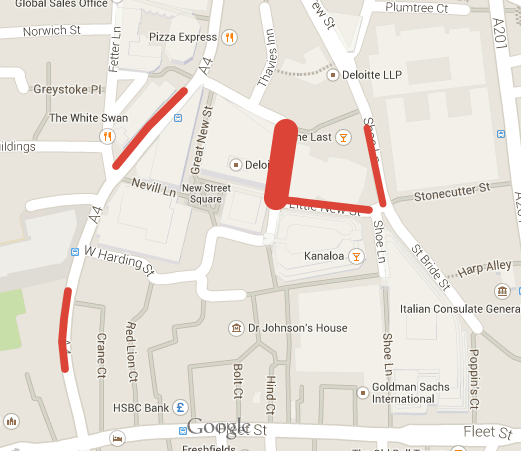In its responses to the consultations on the East-West and
North-South cycle superhighways which are due to meet at Blackfriars Bridge,
the City of London cited two principal concerns.
The first of these, adverse implications for pedestrians in
the City, I have commented on elsewhere.
In short, instead of focussing on the entirely new pedestrian crossings
aligned parallel to the N-S route where it crosses Fleet St and Ludgate Hill
(where currently pedestrians just have to chance their arm – or their leg –crossing
without any form of pedestrian priority), or the restored crossing at the foot
of New Bridge Street near the Black Friar pub (whose removal a few years ago
elicited not even one squeak of protest from the City) or even the proposed
entirely new crossing on the other bank of the Thames, at Stamford Street,
where thousands of city workers walking from waterloo currently have to run the
gauntlet of fast and heavy traffic without any form of priority or protection,
The City instead quibbles about a 20 second increase in waiting time for
pedestrians at one or two crossings. If
they really had their constituents’ interests at heart, don’t you think they would
have attended to those other concerns before now?
The second is the suggestion that the space given over to
the cycle paths and so, partly, taken from moving motor traffic will increase
congestion and so journey times. It is
of course not the City’s fault that TfL has failed to provide any modelling
data on what would happen to congestion and journey times as a result of
transference of journeys from car/taxi to bicycle, or indeed to simple traffic
evaporation (a well known consequence of reducing road capacity). TfL has simply modelled as though traffic
volumes do not change.
However, how sincere is the City’s concern about traffic
congestion? They must surely then be very opposed to anything which takes away road space from motor vehicles and so
exacerbates congestion on their streets?
Don’t you think?
Take a look at this square of the City immediately around my
office building, between Shoe Lane and Fetter Lane, Fleet Street and Holborn.
I have crudely drawn in red lines to indicate road space
which has been expropriated, with the City’s consent, to the exclusive use of
private property developers.
One short stretch has been closed across its entire width,
leaving only the footway passable. This
stretch is being used as the loading/unloading area for materials entering or
leaving the site of Land Securities’ new development at One New Street Square,
the former site of the International Press Centre. I suppose I should be grateful – rumours are
afoot that this building, once completed, will be occupied by my firm, so
allowing us to escape from the 70s multi-storey-car-park monstrosity we occupy
today.
Forming a corner with this, half of the available width of
Little New Street has been expropriated, also for Land Securities, to site
their plant – generators and the like.
And just around the next corner, in Shoe Lane, another
stretch of the road has been expropriated over half of its width, same reasons.
A stone’s throw away, in New Fetter Lane, there are two
similar expropriations, each of about half the road width, adjacent to a new
luxury apartment block nearing completion, and a little further north adjacent
to the redevelopment of Number 20 New Fetter Lane.
What do all of these have I common? They are private uses of public amenity
land. They extend the area on which a
private developer can operate to build a privately owned development. They therefore permit the developer to make
more profits by permitting development of the entire footplate of the site
and/or to facilitate construction operations there.
Now, I am not going to make a value judgement about whether
there is public benefit to be gained from these private arrangements – for
example more profits might mean more taxation on the developer and more square
footage of development might mean higher business rates for the Exchequer – but
I don’t think anyone, not even Canary
Wharf, is denying the manifest public benefit of protected cycle paths into
central London.
So why are they so critical of the perceived congestion
outcomes of the cycleways but apparently perfectly happy to accept similar
implications from private developments?
